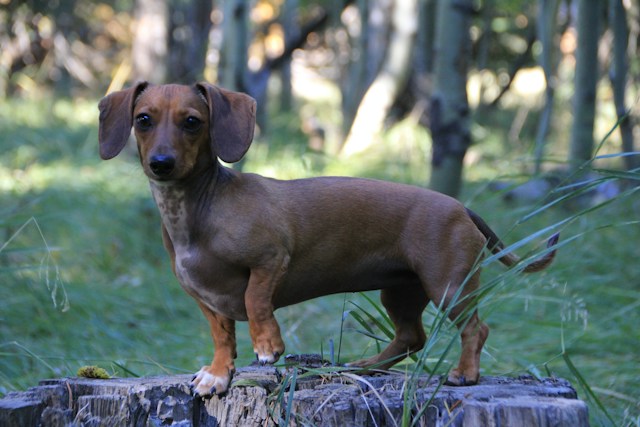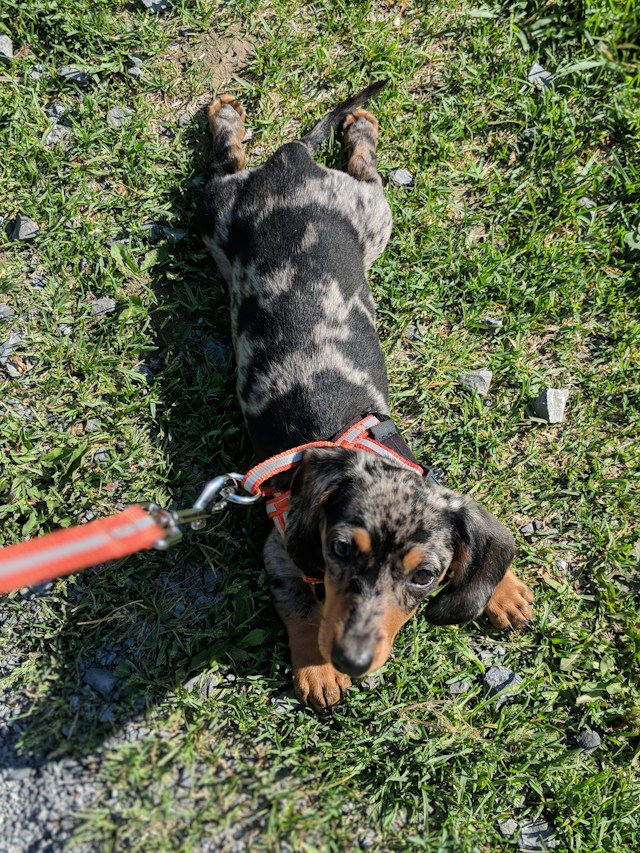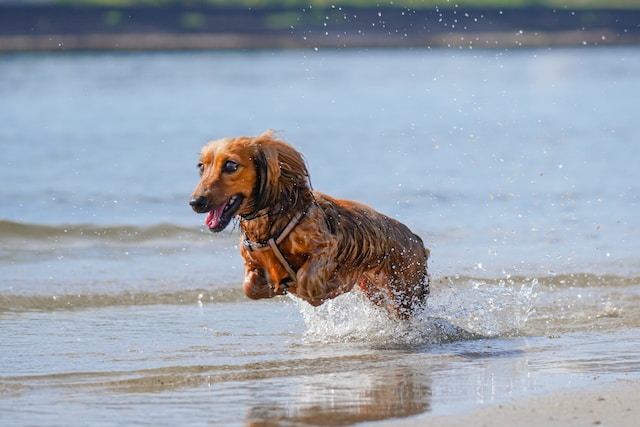“Oh my gosh, look at those cute little legs!” This is what most people say when they see Dachshunds. These furry friends are known for their unique and adorable appearance, but their cute and stubby legs often raise questions about their ability to walk long distances.

The Background of Dachshunds
Dachshunds were originally bred in Germany to hunt badgers and other small animals. Their long, narrow bodies and short legs made them ideal for this job. Since then, they have become popular pets all over the world due to their loving personalities and quirky behavior.
Despite being small in size, these furry friends have an independent spirit that makes them stand out from other breeds. They are intelligent dogs that require mental stimulation as well as physical exercise to stay healthy and happy.
The Physical Characteristics of Dachshunds
Dachshunds are small dogs with a maximum height of 9 inches (standard breed). They weigh between 11-32 pounds depending on the type of breed (standard or miniature). Their long body is supported by four short legs which make them look like sausages on paws.
Their unique body shape can cause health problems such as back issues or joint problems if they are not properly taken care of. Therefore, it’s important to provide regular exercise while keeping safety precautions in mind.

The Thesis Statement: Despite Their Short Legs...
…Dachshunds can walk a lot with proper training and care. Just because they have stumpy legs doesn’t mean they are incapable of going on long walks or hikes with you. In fact, with proper training techniques and precautions taken for their health concerns, Dachshunds can be great companions for outdoor activities.
It’s important to remember that every dog is unique and has different requirements when it comes to exercise. However, the idea that Dachshunds cannot handle long walks simply because of their short legs is a myth.
With patience, consistency, and a little bit of creativity, you can train your furry friend to become a great walking companion. Just because Dachshunds have short legs doesn’t mean they are unable to go on long walks or hikes with their owners.
Taking proper precautions for their health concerns like back problems or joint pains and giving them the proper training can help them become excellent walking companions. So next time you think about keeping your Dachshund indoors because of the misconception that dogs with small legs can’t walk much, grab his/her leash and head out for an adventure together!
The Anatomy of a Dachshund
Overview of the Dachshund's Body Structure
Let’s face it: Dachshunds have an adorable, yet peculiar body structure. With their long bodies and short legs, they may seem unfit for long walks or strenuous physical activity.
However, their unique physique shouldn’t be labeled as a hindrance to their mobility. Dachshunds are known for being brave and energetic dogs that love to explore and play.
They have well-developed muscles in their chest and shoulders that allow them to dig into the ground with their front legs, which makes up for the lack of length in their hind legs. Their spine is also flexible, which enables them to make quick turns and navigate tight spaces with ease.
Explanation of How Their Short Legs Affect Their Mobility
Contrary to popular belief, a dachshund’s short legs do not necessarily impede its ability to walk or run. In fact, with proper training and care, dachshunds can walk for miles without any issues.
However, it is important to note that dachshunds are prone to back problems due to the extra stress on their spinal cords caused by their elongated bodies. Therefore, owners should avoid activities that involve jumping or excessive strain on the back.
Discussion on How to Properly Train a Dachshund for Long Walks
Training a dachshund for long walks may require more patience than training other dog breeds due to their stubbornness. Nonetheless, it is possible with consistent effort.
Start by taking your dachshund on short walks around your neighborhood and gradually increasing the distance over time. Pay attention to your dog’s body language; if they seem tired or uncomfortable, take a break or end the walk altogether.
In addition, invest in a good-quality harness that distributes weight evenly across your dachshund’s body and minimizes any strain on its neck or back. Always bring water and snacks for your furry friend, especially during longer walks.
A dachshund’s unique body structure should not discourage owners from taking them on long walks. With proper care and training, they can enjoy the great outdoors just as much as any other dog breed.

Factors that Affect a Dachshund's Ability to Walk Long Distances
Age and Health
Let’s start with the most obvious factor that affects a Dachshund’s ability to walk long distances – their age and health. Like any other living creature, aging takes its toll on our furry friends, and Dachshunds are no exception.
In fact, they are prone to certain health issues that can make it difficult for them to keep up with you on your daily walks. Intervertebral disc disease is one such issue that can cause mobility problems in Dachshunds.
As they age, their discs degenerate, leading to back problems that can be painful and make it hard for them to walk. But even young Dachshunds can face health challenges that limit their ability to walk long distances.
For example, obesity is becoming increasingly common among these dogs due to overfeeding and under-exercising. If your Dachshund is overweight or obese, you should consult with a veterinarian on how best to help them shed those extra pounds before embarking on any long walks.
Weather Conditions
While we often think of weather conditions as more of an inconvenience for humans than dogs when it comes to walking outside, extreme temperatures can have a serious impact on a Dachshund’s physical well-being during long walks. These dogs are particularly sensitive to heat due in part to their short snouts which makes it difficult for them to regulate their body temperature through panting.
If you’re planning on taking your furry friend out for a walk in hot weather conditions be sure not only take shorter walks but also provide plenty of water. On the other hand cold weather has its own set of challenges as well especially if there is snow or ice present along the walking route as these dogs’ legs are particularly susceptible to injury from slipping and sliding on ice.
Terrain
The terrain on which you take your Dachshund for walks can have a significant impact on their ability to keep up with you. These dogs may be cute, but they are not built for rough terrain or prolonged periods of walking uphill. Their short legs and long bodies make it difficult for them to maintain balance and put pressure on their joints, leading to the risk of injury.
If you must walk your Dachshund through hilly terrain or rocky paths it is best ensure that they are in top physical condition beforehand by starting them off slowly and gradually increasing distance and difficulty level over time. There are several factors that can affect a Dachshund’s ability to walk long distances, including age and health, weather conditions, and the type of terrain they’re walking on.
As responsible pet owners we must ensure that we take these factors into account when planning our walks with this breed. With proper care, exercise, hydration, and attention paid to any potential limitations, Dachshunds can enjoy long walks just like any other dog breed.
Tips for Walking Your Dachshund
Start Slowly: Don't Overexert Your Dachshund!
If you’re new to walking your Dachshund, it’s important to start slow. These little dogs are prone to spinal issues, so overexerting them can cause serious harm. Begin with short walks of around 10-15 minutes, gradually increasing the length and intensity as your pup becomes more comfortable.
This will not only prevent injury but also build up their endurance over time. Another crucial factor when starting out is the pace of your walk.
If you’re walking too fast or too far, your Dachshund may become overwhelmed and tired quickly. Take your time and let them set the pace at first; they’ll soon let you know when they’re ready to speed up or walk a bit farther.
Use Proper Equipment: Invest in High-Quality Leashes and Harnesses
When it comes to equipment for walking your Dachshund, quality is key. A good leash and harness are essential for keeping both you and your pup safe while out on a walk.
Look for a sturdy leash that’s at least six feet long, so that they have plenty of room to explore without getting into trouble. A well-fitting harness is also vital for preventing strain on their delicate necks and backs while out on walks.
Make sure the harness is snug but not too tight; you should be able to fit two fingers comfortably between the harness and their body. Consider investing in specialized equipment like boots or sweaters if you live in an area with extreme weather conditions; this will protect their paws from hot pavement or cold snow.
Take Breaks: Allow Your Dachshund Time to Rest
Just like humans, dogs need rest breaks during prolonged physical activity. Make sure to take frequent breaks during your walks, giving your Dachshund time to rest, rehydrate, and catch their breath.
A fun way to incorporate breaks is by bringing along a collapsible water bowl and a few treats. Not only will this give them something to look forward to during the walk, but it will also ensure they stay hydrated and energized.
Remember, walking with your Dachshund should be a fun bonding experience for both of you. With these tips in mind, you can make the most of your time together while keeping them safe and healthy.

Fun Activities to Keep Your Dachshund Active without Overexertion
Walking isn’t the only way to keep your dachshund active. These furry friends can get their daily dose of exercise through a myriad of fun activities that won’t push them too hard.
Swimming: Making a Splash with Your Dachshund
If you’re looking for a low-impact activity that will keep your dachshund cool in the summer, look no further than swimming. This activity is ideal for dogs with joint problems or those who need to burn off some energy without putting too much strain on their bodies.
Just be sure to supervise your dog closely while they’re in the water and make sure they don’t venture out too far. Before introducing your dachshund to swimming, it’s important to start slowly and make sure they feel comfortable in the water.
Begin by letting them wade in shallow water and gradually move deeper as they become more confident. Always use a life jacket designed for dogs, especially if your dachshund isn’t an experienced swimmer.
Hiking on Flat Terrain: Exploring Nature with Your Dachshund
Hiking is another great way to bond with your furry friend while getting some fresh air and exercise. However, since dachshunds aren’t built for endurance activities, it’s important to choose trails that are flat or have minimal inclines. When hiking with a dachshund, be prepared to take frequent breaks and carry plenty of water for them (and yourself).
Watch out for any signs of exhaustion or discomfort, such as excessive panting or slowing down significantly. It’s always better to err on the side of caution when it comes to your pup’s health.
Playing Fetch: A Classic Game for Active Dachshunds
Playing fetch is a timeless activity that never gets old. Dachshunds love chasing after balls or toys, and it’s an excellent way to burn off their energy while having fun together. However, it’s important to choose the right toys for your dachshund.
Avoid any that are too heavy or large, as they can strain your dog’s back or neck. Instead, opt for soft, lightweight toys that are easy for your pup to carry in their mouth.
When playing fetch with your dachshund, make sure you have plenty of space and avoid throwing the ball too far. Keep an eye on your pup’s body language and take breaks as needed to prevent overexertion or exhaustion.
Conclusion
Dachshunds may have short legs, but they are capable of walking long distances. With proper training, care, and attention to their health and physical limitations, a Dachshund can be a great companion for walking.
It is important to understand that each dog is unique and has different needs when it comes to exercise. However, with the right approach, Dachshunds can enjoy long walks without causing harm.


